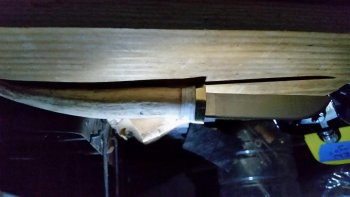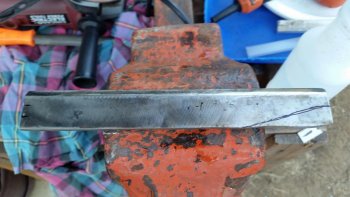wall e
Well-Known Member
I'm Walt and am just starting on making my own knives from old planer blades, due to my limited space and knowledge of metallurgy. I'm open to input from those who have as much experience in this craft as I do on the the planet. I have just started making small easy paring knives and, a chopper, an ugly duke skinner and one combat knife for a friend, made a boning knife and a fillet knife for my dad also. My tools to make knives are limited to a 6 in bench grinder, a 4.5 in angle grinder, a sawzall, a drill, dremel tool, files and, a palm sander.
I am a father and husband who works graveyard so I get a few hrs a week to work on things . I have basic knowledge of shaping steel from working in a steel fab shop and building 4x4s. I am trying to increase my knowledge and versatility of blade types but, don't want to make crap to try and peddle as perfect. I know it is a craft that time and experience as well as patience is important. I literally have only been working with blades a few months and have learned from my mistakes. 1 Steel us sharp when its cut or ground to an edge and rushing ruins things. So if any of the wise old sages have words of wisdom to share with the novice I am willing to listen
I am a father and husband who works graveyard so I get a few hrs a week to work on things . I have basic knowledge of shaping steel from working in a steel fab shop and building 4x4s. I am trying to increase my knowledge and versatility of blade types but, don't want to make crap to try and peddle as perfect. I know it is a craft that time and experience as well as patience is important. I literally have only been working with blades a few months and have learned from my mistakes. 1 Steel us sharp when its cut or ground to an edge and rushing ruins things. So if any of the wise old sages have words of wisdom to share with the novice I am willing to listen






 I came home with 3x.5 myrtlewood scales because, a rifle stock blank got wood worms in it. Also he sent a 4x6x8 chunk of yew wood home with me. So I am planning on making a knife for him by christmas eve with the myrtlewood and brass he sent with me to get started. So if any of you gents have some advice about making scales from myrtlewood and a faster way to drill the blades with out ruining blade or bits please share.
I came home with 3x.5 myrtlewood scales because, a rifle stock blank got wood worms in it. Also he sent a 4x6x8 chunk of yew wood home with me. So I am planning on making a knife for him by christmas eve with the myrtlewood and brass he sent with me to get started. So if any of you gents have some advice about making scales from myrtlewood and a faster way to drill the blades with out ruining blade or bits please share.


